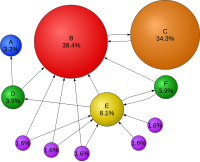
Photo from wikipedia
To accurately rank various web services can be a very challenging task depending on the evaluation criteria used, however, it can play an important role in performing a better selection… Click to show full abstract
To accurately rank various web services can be a very challenging task depending on the evaluation criteria used, however, it can play an important role in performing a better selection of web services afterward. This paper proposes an approach to evaluate trust prediction and confusion matrix to rank web services from throughput and response time. AdaBoostM1 and J48 classifiers are used as binary classifiers on a benchmark web services dataset. The trust score (TS) measuring method is proposed by using the confusion matrix to determine trust scores of all web services. Trust prediction is calculated using 5-Fold, 10-Fold, and 15-Fold cross-validation methods. The reported results showed that the web service 1 (WS1) was most trusted with (48.5294%) TS value, and web service 2 (WS2) was least trusted with (24.0196%) TS value by users. Correct prediction of trusted and untrusted users in web services invocation has improved the overall selection process in a pool of similar web services. Kappa statistics values are used for the evaluation of the proposed approach and for performance comparison of the two above-mentioned classifiers.
Journal Title: IEEE Access
Year Published: 2020
Link to full text (if available)
Share on Social Media: Sign Up to like & get
recommendations!